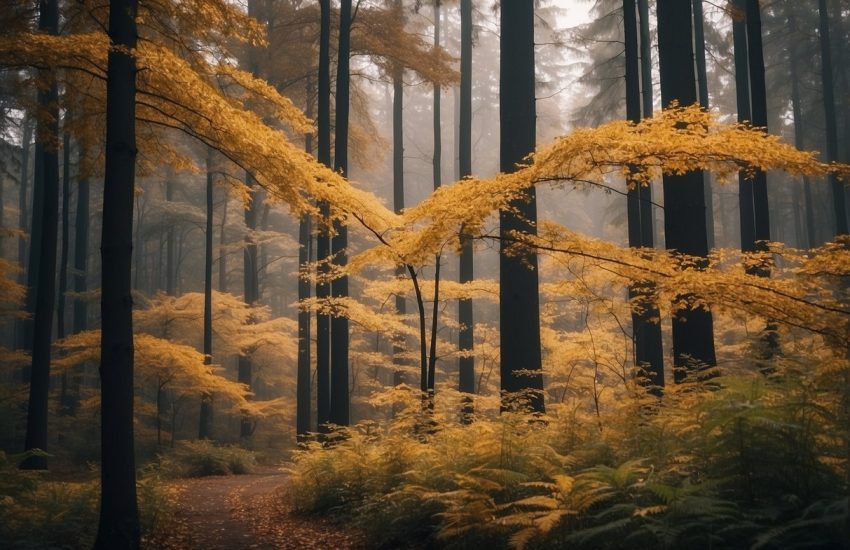15 Ornamental Trees to Grow in Ohio
Ohio is mainly flat and the state is broken up into five separate regions: the Great Lakes Plains, the Appalachian Plateau, the Till Plains, the Bluegrass Region, and the Lake Erie shoreline. Mountains, hills, plains, plateaus, and even arches can all be found in Ohio’s rich lowlands.
It also has dunes and tall clay buffs in addition to clay and sandy beaches. The rugged terrain of the state, comprising steep mountains and deep valleys, is located in the eastern part of the territory. There are caverns and sinkholes in the state, as well as cliffs and deep valleys.
Ohio has typical Midwestern weather, featuring warm summers and cold, snowy winters. Rainy springtime, friendly and slightly moist summers, crisp and stunning autumns, and harsh, snowy winters characterize the climate of the Northeastern part of Ohio. A humid subtropical climate prevails in the state’s southernmost regions.
Ohio hosts several popular flowering trees, such as magnolias and redbuds, because of the state’s diverse topography, fertile soils, and mild climate. Wide varieties of small accent trees and decorative shrubs, including towering Tulip Trees and many others, are cultivated throughout the state.
These blooming trees, no matter where in your yard you choose to plant them, will increase the aesthetic value of your property with their beautiful springtime blooms and fall color. Just ensure the soil and sunlight conditions are ideal for them to thrive. Here are the 15 ornamental trees to grow in Ohio.
1. Redbud
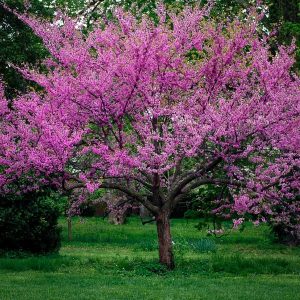
- Time of blooming: Summer.
- Grows up to 20 and 30 feet in height.
Redbuds are incredibly well-liked flowering trees native to the United States and Mexico. These decorative plants are of a manageable size, and they have horizontal branching and several trunks. Their heart-shaped, dark green, deciduous leaves turn a brilliant canary yellow in the fall and possess a rounded crown.
Long-lasting pink flowers develop on redbuds’ tiny magenta stems. These trees require little attention and can grow in a wide range of light and moisture levels. Redbud trees are related to pea plants; thus, their flowers resemble pea flowers. The flowers can be eaten and used to give dishes a tangy, lemony flavor. The buds, before they open, can be pickled and utilized in place of capers.
While redbuds may survive in dappled shade, they bloom better when given full sun. When cultivated in their natural habitat, these trees thrive and are better able to withstand freezing temperatures. It’s best to grow a redbud from seed collected in your area because it likely is the right fit for the environment you are based.
2. Okame Cherry Tree
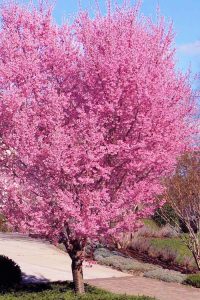
- Late winter/early spring blooming.
- Between 20 and 30 feet tall.
The Okame Cherry Tree was developed in England as an attractive hybrid of the Cherry Tree. It’s an upright evergreen tree with a rounded crown and alternating, simple leaves that turn brilliant shades of orange and bronze in the fall. Its bark, which is polished to a characteristic reddish-brown, stands out.
The flowers of this tree are rosy pink with five petals and a little fragrance; their stems and calyces are a rusty red. Okame flourishes in sunny locations with moderately productive, well-drained, moist loam soil. Once the scaffold branches are in place, this tree needs very little pruning, and the canopy can be shaped to suit your preferred design.
Because the tree’s gorgeous blooms are affixed to the root, any aggressive suckers at the tree’s base should be cut off. This tree may grow by around a foot and a half per year. Add organic mulch to the root zone to keep the roots temperate and moist. Despite its fussy appearance, this tree thrives in various climates and requires little care.
3. Dwarf Korean Lilac
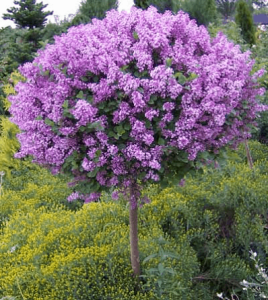
- Blooms in the springtime.
- Height ranges from 5 – 7 ft.
This tree is covered with fragrant, pale pink flowers. You can also prune this little tree into a circular shrub. Its dark green leaves are tiny and broad, ranging from elliptic to obovate in shape. This dwarf variety of the Korean lilac tree prefers full sun and rich, mildly acidic or alkaline soils.
Because of its low maintenance needs, this shrub should only be pruned after it blooms for the season. This tree is an excellent option for those hoping to lure butterflies to their garden. There are no significant drawbacks to it. Upon maturation, a Dwarf Korean Lilac can expect to reach 5 feet.
Due to its low maintenance needs and ground-hugging nature, it is ideally suited for use under overhead power lines. In the unfavorable environment, this tree has a sluggish growth rate. The Lilac has a long projected lifespan of around 30 years.
4. Magnolia
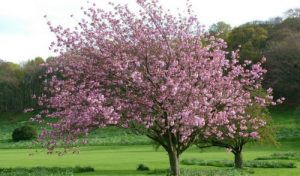
- Time of blooming: Summer.
- Grows up to 40 feet in height.
Among the many native species of trees in the United States, magnolias are among the most widely planted and admired. Their evergreen, bright green, leathery leaves have rusty brown undersides and robust stems and branches.
Massive, cup-shaped, creamy-white, fragrant flowers adorn the dense crown of these medium-sized trees. Magnolias thrive in partial shade to full sun and in soils that are moderately moist, well-drained, and rich in nutrients.
5. Crabapple
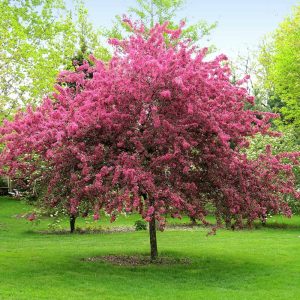
- Blooms in the springtime.
- Grows up to 40 feet in height.
Crabapple is a multipurpose, medium-sized ornamental tree that features elongated, oval, green leaves with sharp points that turn yellow, orange, and red in the fall. Apples of various colors can be clustered together: yellow, green, and red.
This blooming tree can be found in its native habitats in North America, Asia, and Europe, where it bears beautiful groupings of pink and white flowers. Crabapple trees require full or partial sunlight and rich, wet soil with good drainage to flourish.
6. Flowering Dogwood
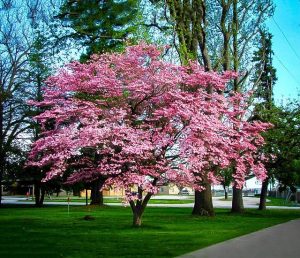
- Blooms in the springtime.
- Reaches 25 feet in height.
As a native of the northern United States and Mexico, dogwoods have become a famous decorative tree. This tree is an excellent addition to any garden because of its deciduous leaves, round to pyramidal shape, flat crown, and clusters of tiny, white flowers.
It has ovate, green leaves that turn a purple-red color in the fall, and its flowers emerge from pink bracts. The best conditions for a dogwood tree are a sunny location with good drainage and organic soil.
7. Star Magnolia
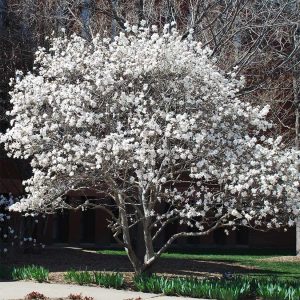
- Blooms in the springtime.
- 20 feet in height.
The Star Magnolia, often known as the Japanese magnolia, is a native of Japan. Famous for its extensive, star-shaped, white, fragrant flowers, the Star Magnolia is a well-known Magnolia tree species.
The flowers on this tree are nothing short of stunning, with their long, ribbon-shaped petals and their noticeable pale yellow centers. This attractive, flexible, and pest-resistant plant does best in full sun to partial shade and in well-drained soil.
8. Hawthorn
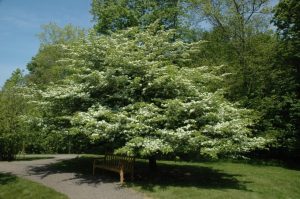
- The flowering season for these trees is spring.
- Between 20 and 30 feet in height.
Hawthorn trees, which can range in size from relatively tiny to quite large, are deciduous and produce flowers in the temperate regions of Asia, North America, Africa, and Europe. Blooms on these trees are either white or pink and have five petals, just like apple flowers, but the tree itself has a spreading crown and grows erect.
Hawthorn trees produce berries that are both tasty and attractive to birds. These trees can withstand dry periods and thrive in a variety of soil and exposure to sunlight environments.
9. Tulip Tree
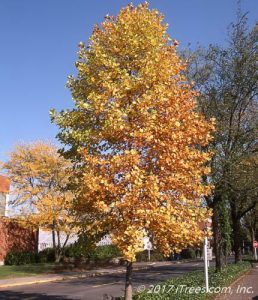
- As the spring progresses into summer, it begins to bloom.
- Grows to 70 m to 90 m in height.
This tree is a tall, stately flowering plant with a rounded, elliptical, or pyramidal crown and brilliant green, 4-lobed, glossy leaves. The flowers of this native of eastern North America are greenish-yellow on top and orange on the bottom.
The fruits of this tree likewise take the form of a cone. Tulip trees prefer full sun and acidic, loamy soil with good drainage. This tree does best in full sun, which entails a minimum of six hours of unobstructed sunlight daily.
10. Western Mountain Ash
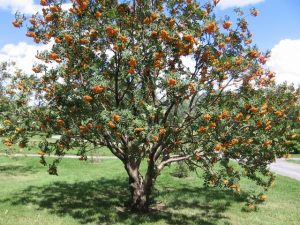
- Blooms in the first weeks of spring.
- Grows to a height between 10 and 30 feet.
Western Mountain Ash is a comparatively tiny, deciduous, multi-stem flowering plant with thin, scaly bark and a round crown. The blue-green leaflets of this tree are alternating, pinnately complex, stalkless, elliptic, and pointy at both ends. It blooms clusters of white flowers with a flat tip.
The Western Mountain Ash produces fruit that resembles an apple but is smaller and orange in color and is bitter and acidic. This tree prefers full sun and medium-to-high fertility, well-drained soil.
11. Japanese Tree Lilac
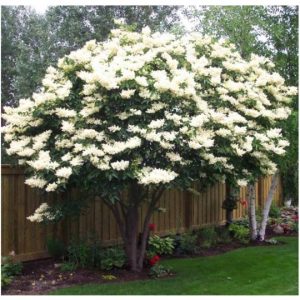
- Early Summer Flowering Time.
- Grows to 5-10 m in height.
Japanese Tree Lilac Trees are little, multi-trunked flowering trees. This flowering tree has glossy, dark green leaves that stand in striking contrast to the fragrant, tiny, creamy-white flowers that hang from the tree in enormous, drooping clusters. This tree is a low-maintenance plant that does best in sunny areas with medium-moist, well-drained soil.
This tree requires routine maintenance pruning as any other tree or shrub. To lessen the likelihood of a significant insect or disease infestation, promptly remove any damaged, dead, or diseased branches. Please pay special attention to tangling branches and prune them away. Older trees should have portions of their inner branches periodically pruned to promote airflow further.
12. Limelight Hydrangea Tree
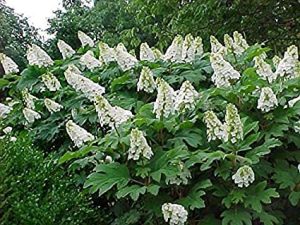
- Bloom Time: Late spring through summer.
- Reaches a height of 3-6 meters.
The Limelight Hydrangea Tree, is a dwarf variety of the giant Panicle Hydrangea. It grows tall, thick panicles in the shape of a cone, and its flowers, which are mainly infertile, turn color as they age. As they open, they are a pale, milky white, evolving into bright lime green and a deep pink or rose.
It has dark green foliage that turns crimson in the fall and oval in shape and serrate. The Limelight Hydrangea Tree in Ohio prefers partial shade to full sun and organically rich soils, well-drained soils, and at a medium moisture level for optimal growth.
13. Plumeria Tree
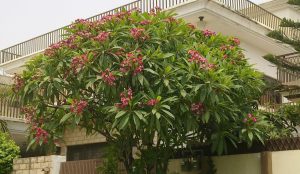
- Blooms throughout the late spring, summertime, and fall.
- Reaches 25 feet in height.
Small, round trees with a vase-shaped top and squishy branches characterize the Plumeria Tree, commonly known as the Nosegay Tree. Dry, hot climates in Central America and Venezuela are their natural habitat and can be grown in other tropical regions.
The clusters of pink to crimson flowers these trees produce are incredibly fragrant and feature five petals each. Their leaves are oval and dark green, and their margins are undulating. Plumeria trees require full or partial sun and loamy, well-drained soil that is dry to medium damp.
14. Weeping Cherry
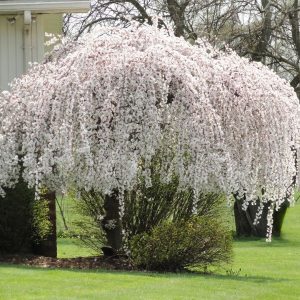
- Blooms in the springtime.
- Grows to 5-10 m in height.
Japanese nature gave the world the beautiful weeping cherry tree. These tiny grafted flowering trees feature clusters of white and pale pink flowers on trailing limbs. Eventually, the double blossoms will give way to dark, almost black, fruits around the size of pears.
This trees have green leaves that are either lanceolate or ovate. They do best in full sun and on rich, nutritious soil that stays moist yet drains well.
15. Witch Hazel
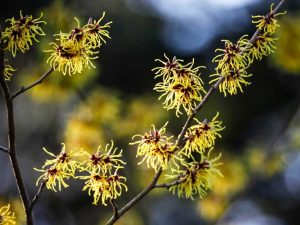
- Blooms in late winter/early spring.
- Reaches a height of 10-20 feet.
The first known witch hazel trees were discovered in eastern North America. They are blooming trees of medium stature that have dark to medium green, deciduous, oval to obovate leaves with wavy margins.
The flowers of the witch hazel tree are bright yellow and crinkly; they bloom in groups around the trunk and have a distinctive form to their petals. These trees thrive in sunny or partially shaded locations with fertile, medium-moisture, organic soils.
FAQs: Ornamental Trees for Ohio Gardens
- What are the best plants to grow in an Ohio garden? Ohio’s diverse topography and climate make it suitable for a variety of ornamental trees. Some excellent choices include the Redbud, a native tree with heart-shaped leaves and pink flowers; the Dwarf Korean Lilac, known for its fragrant, pale pink flowers; and the Limelight Hydrangea Tree, a dwarf variety with changing flower colors.
- Which trees grow well in Ohio’s specific climate and conditions? Ohio’s climate, characterized by warm summers and snowy winters, is ideal for several ornamental trees. The Redbud, Magnolia, Crabapple, and Flowering Dogwood all thrive in Ohio’s varied weather conditions. Additionally, the Western Mountain Ash and Witch Hazel are adaptable to different soil and sunlight environments.
- Are there any rare trees suitable for Ohio gardens? The Okame Cherry Tree and Japanese Tree Lilac are noteworthy choices. The Okame Cherry Tree, with its rosy pink flowers and attractive bark, is a hybrid developed in England. The Japanese Tree Lilac, a multi-trunked flowering tree with fragrant, creamy-white flowers, adds a unique touch to Ohio gardens.
- Can I find trees that bloom in late spring or early summer for my Ohio garden? Yes, several trees from the list fit this criterion. The Plumeria Tree, with its clusters of pink to crimson flowers, blooms throughout late spring, summer, and fall. The Star Magnolia, known for its extensive, star-shaped, white flowers, also blooms in the springtime.
- Are there ornamental trees suitable for challenging climates in Ohio? Yes, the Okame Cherry Tree is known for thriving in various climates with little care required. Similarly, the Plumeria Tree, native to dry, hot climates, can be grown in tropical regions of Ohio.


